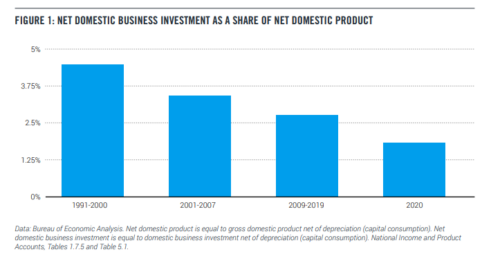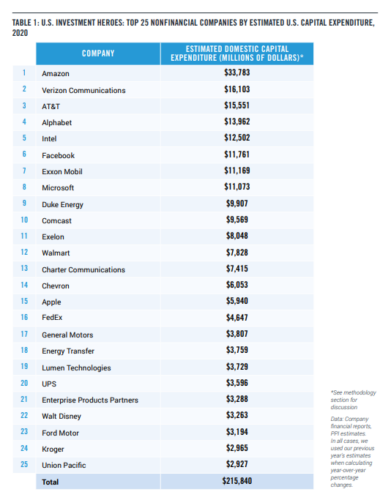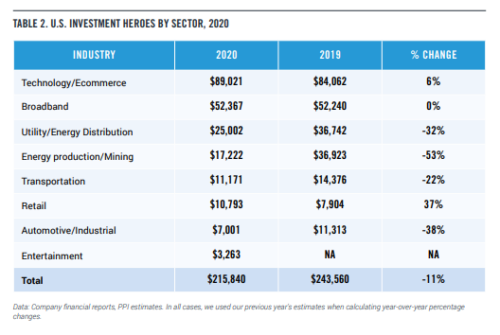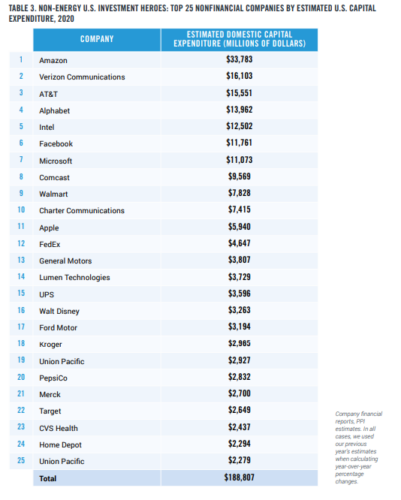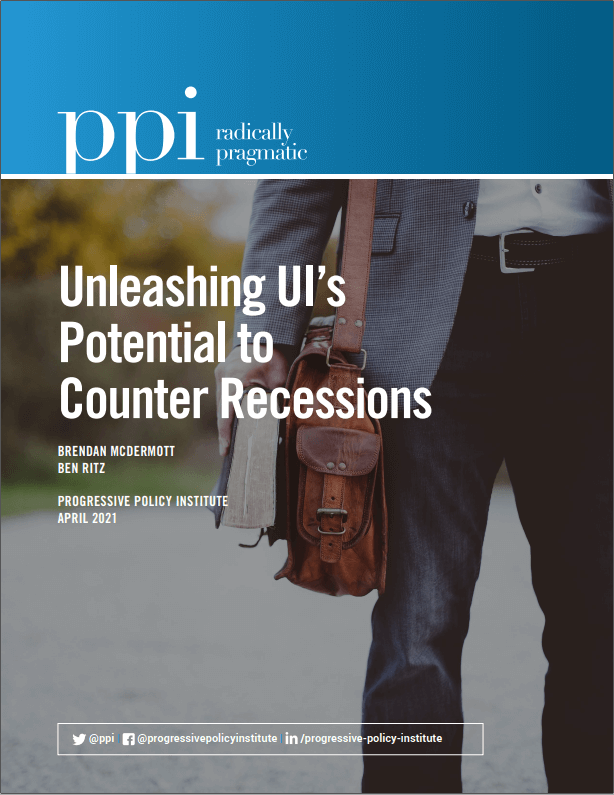Amazon’s $34 Billion Makes It an ‘Investment Hero,’ Study Says
The e-commerce giant was far and away the leader in U.S. capital spending in 2020, according to a Progressive Policy Institute analysis.
By Peter Coy
Democratic and Republican politicians alike are dumping on Amazon.com Inc. over its ceaseless expansion—marked most recently by its agreement to buy the movie studio with the roaring lion logo, Metro-Goldwyn-Mayer. Representative David Cicilline, a Rhode Island Democrat, says “they are laser-focused on expanding and entrenching their monopoly power,” while Senator Josh Hawley, a Missouri Republican, tweets that Amazon “shouldn’t be able to buy anything else. Period.”
But not everybody is mad at Amazon. A new study from the Progressive Policy Institute, which was founded in 1989 as a centrist Democratic think tank and promises “radically pragmatic thinking,” calls Amazon its No. 1 “investment hero.” It estimates that Amazon boosted its U.S. capital spending by 75% in 2020, to $33.8 billion, from the year earlier, which was more than twice that of any other company.
The study names 25 investment heroes based on their U.S. capital spending. The rest of the top five for 2020 are Verizon Communications, $16.1 billion; AT&T, $15.6 billion; Google’s parent Alphabet, $14 billion; and Intel, $12.5 billion.
“The willingness of these companies to keep spending essentially made it possible for large chunks of the economy to move forward despite the pandemic,” says the report. “Investment by broadband and tech companies kept people connected at home during the shock of the lockdown; and the investment by e-commerce firms helped keep essential goods flowing while many Americans could not go out shopping.”
The report is by Michael Mandel, the institute’s chief economic strategist, and Elliott Long, a senior economic policy analyst. Mandel was chief economist of BusinessWeek, the predecessor to Bloomberg Businessweek (making him my former boss). He is also a senior fellow at the Mack Institute for Innovation Management of the Wharton School at the University of Pennsylvania.
Critics of Amazon say it costs jobs by putting smaller retailers out of business. But in an email exchange, Mandel wrote that “the number of workers added by e-commerce exceeds jobs lost by brick and mortar.” The main reason, he wrote, is that e-commerce customers are creating jobs for drivers, warehouse workers, and others, who are freeing them from having to shop in person. “Investment in e-commerce is job-creating because it replaces unpaid household shopping hours, which have fallen dramatically,” Mandel wrote.
This is the 10th annual edition of the investment heroes report by the Progressive Policy Institute. It’s based on gross investment—i.e., before accounting for the effects of depreciation. The numbers come from company reports. The authors made estimates when the companies didn’t break out U.S. investment separately. Most financial companies, excluding health insurance companies, were excluded. For Amazon, which relies heavily on finance leases, the report included principal repayment on those leases as a form of investment.
The report takes a shot at critics in the camp of Cicilline and Hawley, without naming names. “It seems odd that Congress seems more interested in sharply questioning companies that are investing heavily in America, rather than those that have reduced investment or actually disinvested in this country,” it says.
The Progressive Policy Institute gets general funding from some of the companies on the heroes list, Mandel wrote in an email. But he says “the methodology only uses publicly available data and a consistent procedure that can be replicated.”
The MGM deal was announced after the report was completed. (Acquisitions don’t count toward companies’ capital spending numbers in the report.) In an email, Mandel wrote, “This deal potentially increases the level of competition in the growing market for streaming content. The key is to watch Amazon’s investment behavior. If Amazon invests in producing more content based on MGM intellectual property, as seems likely, that means lower prices for consumers and more content production jobs.”
In announcing the deal on May 26, the company stated, “Amazon will help preserve MGM’s heritage and catalog of films, and provide customers with greater access to these existing works.” Amazon didn’t immediately respond to a request for comment on this story.
The PPI report is lukewarm on President Joe Biden’s American Jobs Plan. The authors praise its provisions for investment in infrastructure, research and development, and manufacturing. But they write that the corporate income tax increases in the plan “could discourage business investment at a time when capital spending is already weak.”
Not every economist agrees with that. Thomas Philippon, a finance professor at New York University’s Stern School of Business, argues that for many companies, a higher tax on their profits would not induce them to decrease investment significantly because a substantial share of their profits are “excess”—meaning they’re above what companies require to justify investment for growth. (Excess profits, an economic concept rather than an accounting one, are generated by companies with monopolies or near-monopolies in their market sectors.)
Mandel wrote, “The weight of the evidence shows that corporate tax rates adversely affect investment.”
Read the story here.



